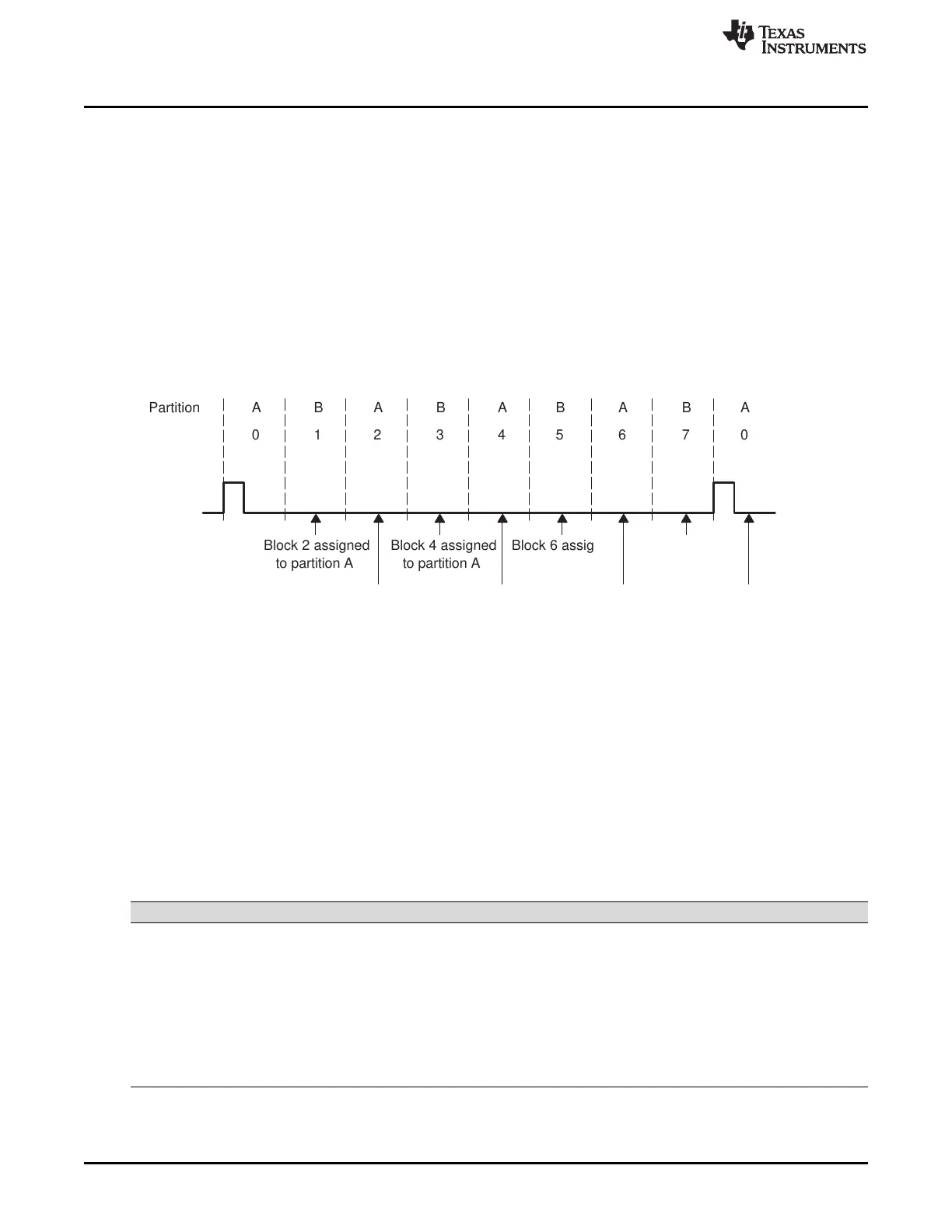0-15112-12796-11180-9564-7948-6332-4716-310-15
Block
Channels
FS(R/X)
ÁÁÁÁÁÁÁÁÁÁÁÁÁÁÁÁÁÁÁÁÁÁÁÁÁ
ÁÁÁÁÁÁÁÁÁÁÁÁÁÁÁÁÁÁÁÁÁÁÁÁÁ
ÁÁÁÁÁÁÁÁÁÁÁÁÁÁÁÁÁÁÁÁÁÁÁÁÁ
ÁÁÁÁÁÁÁÁÁÁÁÁÁÁÁÁÁÁÁÁÁÁÁÁÁ
0 1 2 3 4 5 6 7 0
Partition A B A B A B A B A
Block 2 assigned
to partition A
Block 4 assigned
to partition A
Block 6 assigned
to partition A
Block 0 assigned
to partition A
Block 3 assigned
to partition B
Block 5 assigned
to partition B
Block 7 assigned
to partition B
Block 1 assigned
to partition B
Two-partition mode. Example with changing block assignments
Multichannel Selection Modes
www.ti.com
688
SPRUI07–March 2020
Submit Documentation Feedback
Copyright © 2020, Texas Instruments Incorporated
Multichannel Buffered Serial Port (McBSP)
Several features of the McBSP help you time the reassignment:
• The block of channels currently involved in reception/transmission (the current block) is reflected in the
RCBLK/XCBLK bits. Your program can poll these bits to determine which partition is active. When a
partition is not active, it is safe to change its block assignment and channel configuration.
• At the end of every block (at the boundary of two partitions), an interrupt can be sent to the CPU. In
response to the interrupt, the CPU can then check the RCBLK/XCBLK bits and update the inactive
partition. See Section 12.6.8.
Figure 12-33 shows an example of reassigning channels throughout a data transfer. In response to a
frame-synchronization pulse, the McBSP alternates between partitions A and B. Whenever partition B is
active, the CPU changes the block assignment for partition A. Whenever partition A is active, the CPU
changes the block assignment for partition B.
Figure 12-33. Reassigning Channel Blocks Throughout a McBSP Data Transfer
12.6.5 Using Eight Partitions
For multichannel selection operation in the receiver and/or the transmitter, you can use eight partitions or
two partitions (described in Section 12.6.4). If you choose the 8-partition mode (RMCME = 1 for reception,
XMCME = 1 for transmission), McBSP channels are activated in the following order: A, B, C, D, E, F, G,
H. In response to a frame-synchronization pulse, the receiver or transmitter begins with the channels in
partition A and then continues with the other partitions in order until the complete frame has been
transferred. When the next frame-synchronization pulse occurs, the next frame is transferred, beginning
with the channels in partition A.
In the 8-partition mode, the (R/X)PABLK and (R/X)PBBLK bits are ignored and the 16-channel blocks are
assigned to the partitions as shown in Table 12-11 and Table 12-12. These assignments cannot be
changed. The tables also show the registers used to control the channels in the partitions.
Table 12-11. Receive Channel Assignment and Control With Eight Receive Partitions
Receive Partition Assigned Block of Receive Channels Register Used For Channel Control
A Block 0: channels 0 through 15 RCERA
B Block 1: channels 16 through 31 RCERB
C Block 2: channels 32 through 47 RCERC
D Block 3: channels 48 through 63 RCERD
E Block 4: channels 64 through 79 RCERE
F Block 5: channels 80 through 95 RCERF
G Block 6: channels 96 through 111 RCERG
H Block 7: channels 112 through 127 RCERH

